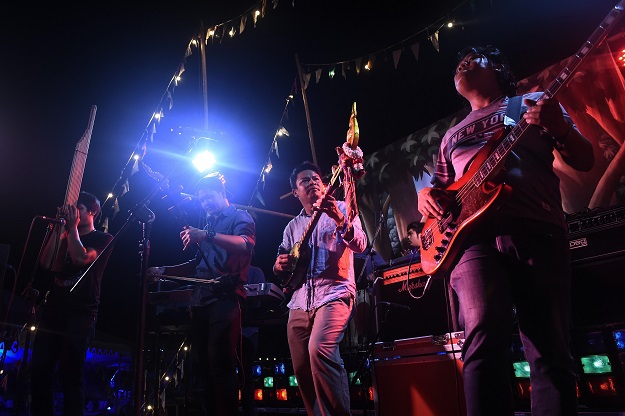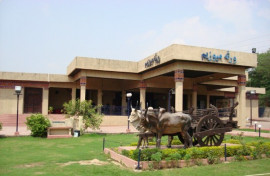
CHON BURI: Hipsters in flowing skirts and crop tops sway to the Thai band's hypnotic groove at an exclusive music festival in Thailand, while a clutch of cleaning staff quietly look on from the fringes.
"I had no idea foreigners like molam," says 55-year-old Saengyan Promduang, referring to the folk tunes unique to her rural home region that are captivating the well-heeled crowd outside Bangkok. Alternately sunny and haunting, the molam sound was once sneered at by wealthy Thais as 'poor people music' from the rice-farming northeast, a region with closer cultural links to Laos.
Painted Thai elephants spray tourists with water to banish bad luck
But fresh takes on the centuries-old musical tradition have started winning over Bangkok's hipster elite and are making waves in the world music scene. It is a stark turnaround from decades of cultural condescension towards the region known as Isaan - home to rice farmers and the millions of migrants who fill Bangkok's working class.
Like many from their region, the cleaners left their fields for better pay working for affluent Thais and ex-pats in the capital. In February their work took them to 'Wonderfruit', an upscale art and music festival held in a field several hours south of Bangkok.
 Festivalgoer looking inside the Molam Bus at the Wonderfruit music festival in Chonburi. PHOTO: AFP
Festivalgoer looking inside the Molam Bus at the Wonderfruit music festival in Chonburi. PHOTO: AFP"I'm not surprised they like molam, but I am proud," said Komkang Thaptham, 43, letting her garbage bag rest on the ground as she watched homegrown rockers from All-Thidsa band put on a show for a mix of urban Thais, tourists and expats.
In its simplest form molam features witty - and often bawdy - lyrics about rural life warbled over the rhythmic swells of the kaen, a bamboo reed organ played by mouth. But the genre has changed its tune with the times, going electric in the 1960s and filtering in the sounds of psychedelic rock and funk played by American soldiers deployed in the region.
 An old photograph of molam performers on display inside the Molam Bus at the Wonderfruit music festival in Chonburi. PHOTO: AFP
An old photograph of molam performers on display inside the Molam Bus at the Wonderfruit music festival in Chonburi. PHOTO: AFPMolam's rising global profile today has much to do with two vinyl-obsessed DJs who started digging up 60s-era Thai folk records a decade ago and spinning the vintage beats in Bangkok. "Most of the people I met in Bangkok during that time would ask me, 'why do you play and collect molam records? It's poor people music, it's music for taxi drivers'," recalled Nattapon Siangsukon, a Thai DJ better known by his stage name Maft Sai.
But the Isaan club nights started pulling crowds, inspiring Maft Sai and fellow DJ Chris Menist to invite a colourful collection of molam veterans - some on the brink of retirement - to the capital for live shows.
 Festivalgoers checking out the Molam Bus at the Wonderfruit music festival in Chonburi. PHOTO: AFP
Festivalgoers checking out the Molam Bus at the Wonderfruit music festival in Chonburi. PHOTO: AFPIn 2012 they minted the Paradise Bangkok Molam International Band, a six-piece ensemble that has five European tours under its belt, including stops at the UK's hallowed Glastonbury festival. The group has dropped molam's trademark vocals but captures its mesmeric feel with two Isaan legends driving foot-tapping grooves on the kaen and phin, a pear-shaped lute native to the northeast. The band still draws bigger crowds abroad than on home soil.
But Thais are increasingly catching on, with Bangkok hipsters giving the two molam masters Kammao Perdtanon and Sawai Kaewsombat - who are twice the age of the youngest band member - a rock star welcome when they strode onto the stage at a recent show.
 All-Thidsa molam band performing on stage at the Wonderfuit music festival in Chonburi. PHOTO: AFP
All-Thidsa molam band performing on stage at the Wonderfuit music festival in Chonburi. PHOTO: AFP"At the end of the day when music is good it speaks for itself," Maft Sai told AFP as the band members trickled into their Bangkok studio space for a rehearsal. "It is quite honest music, and people can feel that."
The group's new record, 'Planet Lam', has woven more modern layers into the traditional sounds, playing with dub and electronica elements. Experimentation has also held the key to success for Rasmee Wayrana, an Isaan native who has melded sultry molam vocals with a jazzy back-up band and is building a growing fanbase at home and abroad.
 Festivalgoers dancing to the All-Thidsa molam band performing on stage at the Wonderfuit music festival in Chonburi. PHOTO: AFP
Festivalgoers dancing to the All-Thidsa molam band performing on stage at the Wonderfuit music festival in Chonburi. PHOTO: AFPFor Khun Narin's Electric Phin Band, another molam group on the European festival circuit, fame came through a very 21st century stroke of fortune. The motley crew of musicians were used to playing rural wedding gigs in northern Thailand. But they were propelled to international fame after an American producer stumbled across clips of their raucous village parties on YouTube.
Entranced by the electric phin riffs booming out of their homemade PA system, he flew out to Thailand to track the group down and record their first album in 2014. The band has been busy since releasing a second record with the US label, touring Europe twice and keeping day jobs as rice farmers, students, janitors and factory workers when back home.
15 unique festivals around the world that must go on your bucket list
While some traditionalists lament modern molam's departure from its acoustic roots, others see its evolution as the next chapter in an art form that has always been about change. "It refreshes itself all the time," said Arthit Mulsarn, the curator of a roving exhibit, known as the 'Molam Bus Project', that chronicles the history of the genre.
"I don't think molam is better or worse now, I think it just changes as time changes."



































































COMMENTS
Comments are moderated and generally will be posted if they are on-topic and not abusive.
For more information, please see our Comments FAQ